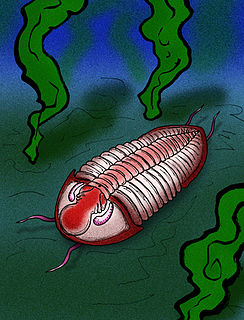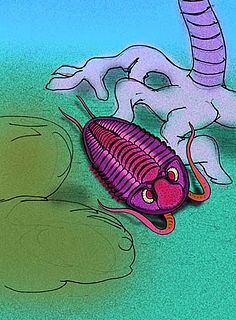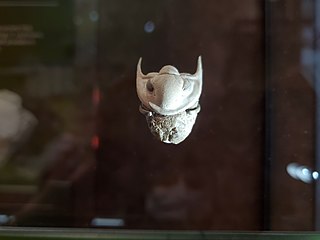The Permian is a geologic period and stratigraphic system which spans 47 million years from the end of the Carboniferous Period 298.9 million years ago (Mya), to the beginning of the Triassic Period 251.9 Mya. It is the last period of the Paleozoic Era; the following Triassic Period belongs to the Mesozoic Era. The concept of the Permian was introduced in 1841 by geologist Sir Roderick Murchison, who named it after the region of Perm in Russia.

Trilobites are extinct marine arthropods that form the class Trilobita. Trilobites form one of the earliest-known groups of arthropods. The first appearance of trilobites in the fossil record defines the base of the Atdabanian stage of the Early Cambrian period and they flourished throughout the lower Paleozoic before slipping into a long decline, when, during the Devonian, all trilobite orders except the Proetida died out. The last extant trilobites finally disappeared in the mass extinction at the end of the Permian about 252 million years ago. Trilobites were among the most successful of all early animals, existing in oceans for almost 270 million years, with over 22,000 species having been described.

Proetida is an order of trilobite that lived from the Ordovician to the Permian. It was the last order of trilobite to go extinct, finally dying out in the Permian-Triassic extinction event.

Rusophycus is a trace fossil ichnogenus allied to Cruziana. Rusophycus is the resting trace, recording the outline of the tracemaker; Cruziana is made when the organism moved. The sculpture of Rusophycus may reveal the approximate number of legs that the tracemaker had, although striations (scratchmarks) from a single leg may overlap or be repeated.

Holochroal eyes are compound eyes with many tiny lenses. They are the oldest and most common type of trilobite eye, and found in all orders of trilobite from the Cambrian to the Permian periods. Lenses covered a curved, kidney-shaped visual surface in a hexagonal close packing system, with a single corneal membrane covering all lenses. Unlike in schizochroal eyes, adjacent lenses were in direct contact with one another. Lens shape generally depended on cuticle thickness. The lenses of trilobites with thin cuticles were thin and biconvex, whereas those with thick cuticles had thick lenses, which in extreme cases, could be thick columns with the outer surface flattened and the inner surface hemispherical. Regardless of lens thickness, however, the point at which light was focused was roughly the same distance below the lens.

Endops yanagisawai is a proetid trilobite belonging to the family Proetidae, endemic to Middle Permian-aged marine strata in Fukushima Prefecture, Japan. It was originally described by Riuji Endo as Paladin yanagisawai.

Proetidae is a family of proetid trilobites. The first species appeared in the Upper Ordovician, and the last genera survived until the Middle Permian. However, if the closely related family Phillipsiidae is actually a subfamily of Proetidae, then the proetids of Proetidae survive until the end of the Permian, where the last perish during the Permian–Triassic extinction event.

Phillipsiidae is a family of proetid trilobites, the various genera of which comprise some of the last of the trilobites, with a range that extended from the Kinderhookian epoch of the Lower Mississippian, to the end of Changhsingian age at Permian-Triassic extinction event in the latest Permian period.

Cummingella is a genus of proetid trilobite in the family Phillipsiidae that lived from the earliest Carboniferous until the last species' extinction in the Middle Permian. Fossils have been found in corresponding marine strata of Western Europe, the United Kingdom and the United States.

Paleontology in Indiana refers to paleontological research occurring within or conducted by people from the U.S. state of Indiana. Indiana's fossil record stretches all the way back to the Precambrian, when the state was inhabited by microbes. More complex organisms came to inhabit the state during the early Paleozoic era. At that time the state was covered by a warm shallow sea that would come to be inhabited by creatures like brachiopods, bryozoans, cephalopods, crinoids, and trilobites. During the Silurian period the state was home to significant reef systems. Indiana became a more terrestrial environment during the Carboniferous, as an expansive river system formed richly vegetated deltas where amphibians lived. There is a gap in the local rock record from the Permian through the Mesozoic. Likewise, little is known about the early to middle Cenozoic era. During the Ice Age however, the state was subject to glacial activity, and home to creatures like short-faced bears, camels, mammoths, and mastodons. After humans came to inhabit the state, Native Americans interpreted the fossil proboscidean remains preserved near Devil's Lake as the bones of water monsters. After the advent of formal scientific investigation one paleontological survey determined that the state was home to nearly 150 different kinds of prehistoric plants.

Paleontology in Oklahoma refers to paleontological research occurring within or conducted by people from the U.S. state of Oklahoma. Oklahoma has a rich fossil record spanning all three eras of the Phanerozoic Eon. Oklahoma is the best source of Pennsylvanian fossils in the United States due to having an exceptionally complete geologic record of the epoch. From the Cambrian to the Devonian, all of Oklahoma was covered by a sea that would come to be home to creatures like brachiopods, bryozoans, graptolites and trilobites. During the Carboniferous, an expanse of coastal deltaic swamps formed in areas of the state where early tetrapods would leave behind footprints that would later fossilize. The sea withdrew altogether during the Permian period. Oklahoma was home a variety of insects as well as early amphibians and reptiles. Oklahoma stayed dry for most of the Mesozoic. During the Late Triassic, carnivorous dinosaurs left behind footprints that would later fossilize. During the Cretaceous, however, the state was mostly covered by the Western Interior Seaway, which was home to huge ammonites and other marine invertebrates. During the Cenozoic, Oklahoma became home to creatures like bison, camels, creodonts, and horses. During the Ice Age, the state was home to mammoths and mastodons. Local Native Americans are known to have used fossils for medicinal purposes. The Jurassic dinosaur Saurophaganax maximus is the Oklahoma state fossil.
Anomphalus jaggerius is an extinct species of Permian sea snail. Fossils have been found in Artinskian era limestone from the Bird Spring Formation in the southern Arrow Canyon Range of the US State of Nevada. The species, which had a shell 6.37 millimetres (0.251 in) wide, was a subtidal epifaunal grazer. It was named after Rolling Stones lead singer Mick Jagger.

Triroetus is a genus of proetid trilobite found in Upper Carboniferous-aged marine strata in Russia, and Lower Permian-aged strata of Thailand, Malaysia, Spitzbergen, Yukon Territory, and Middle Permian-aged marine strata of Oman and Texas.

Thaiaspis is a genus of proetid trilobite belonging to the family Phillipsiidae. Fossils of the various species are found in Middle to Late Mississippian-aged marine strata of eastern Asia, especially of Carboniferous-aged marine strata in Thailand.

Vidria vespa is a proetid trilobite belonging to the family Phillipsiidae. The fossils are found in Middle Permian-aged marine strata of Western Texas. It is unique among Permian-aged trilobites in having a posterior spine emanating from the pygidium of the adult.
Paladin is a genus of trilobite which lived 354-259 Ma, during the Late Paleozoic era; more specifically, during the Carboniferous and Permian periods. It was widespread: fossils have been discovered in what are now East Asia, Europe and North America.
Ditomopyge is an extinct genus of trilobite belonging to the family Proetidae. It was extant during the Carboniferous and Permian and is widely distributed, with fossils found in Europe, southwest Asia, southeast Asia, Australia, North America, and South America.

Ameura is an extinct genus of trilobite belonging to the family Proetidae. Fossils from the genus have been found in late Paleozoic beds in North America.

Anisopyge is an extinct genus of trilobite belonging to the order Proetida and family Phillipsiidae. Specimens have been found in Permian beds in North and Central America.
Pseudophillipsia is a genus of trilobite, notable for it being one of the last members of the group before the extinction at the end of the Permian. It first appeared during the Pennsylvanian or Late Carboniferous.















